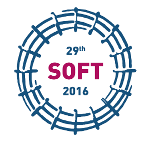Speaker
Dai Hamaguchi
(Fusion Research and Development Directorate)
Description
Copper is the candidate material for cooling components for divertor and other plasma facing components. Although CuCrZr alloy is a first choice regarding strength, toughness, and conductivities, issues related to quality control during manufacturing process and also on the possible loss of strength during brazing among fabrication of the components still remains. CuCrZr also exhibit some weakness against neutron irradiations, e.g. pronounce loss of ductility at very low doses below 150˚C. One of the keys to deal with these issues is a grain refinement.
Friction Stir Processing (FSP) is a solid-state process in which a rotational tool is plunged into the work piece to produce local friction heating inducing complex material flow and intense plastic deformation. The important feature of this process is strengthening but also is ultra-grain refinement, which is expected to improve irradiation resistivity. The purpose of this study is to examine the applicability of FSP to copper and its alloys to improve material’s performances.
In FSP, material flow induced by friction heating depends on the rotation speed. To examine the effect of rotation speed, variety of rotation speed from 50 to 500rpm was tested on pure Cu with fixed vertical force of 1.5t. The result indicates that the most effective grain refinement can be achieved at the rotation speed of 100 to 200rpm with hardness increase of about 50%, but the introduction of the defects like cavities and local cracks were also seen. For better FSP performance, compulsory cooling with liquid CO2 during the process was also tested and finer grain size was achieved compared to non-cooling tests at the same and greater rotation speeds, and consequently defect formations was also suppressed. Based on these results on pure Cu, the examination on ITER-Gr CuCrZr alloy was also conducted. The details will be reported on the presentation.
Co-authors
Dai Hamaguchi
(Fusion Research and Development Directorate, Japan Atomic Energy Agency, 2-166 Oaza-Obuchi-Aza-Omotedate, Rokkasho, Kamikita-gun, Aomori 0393212, Japan)
Hidetoshi Fuji
(Joining and Welding Research Institute, Osaka University, 11-1 Mihogaoka, Ibaraki, Osaka 5670047, Japan)
Hiroyasu Tanigawa
(Fusion Research and Development Directorate, Japan Atomic Energy Agency, 2-166 Oaza-Obuchi-Aza-Omotedate, Rokkasho, Kamikita-gun, Aomori 0393212, Japan)
Kazumi Ozawa
(Fusion Research and Development Directorate, Japan Atomic Energy Agency, 2-166 Oaza-Obuchi-Aza-Omotedate, Rokkasho, Kamikita-gun, Aomori 0393212, Japan)
Yoshiaki Morisada
(Joining and Welding Research Institute, Osaka University, 11-1 Mihogaoka, Ibaraki, Osaka 5670047, Japan)

